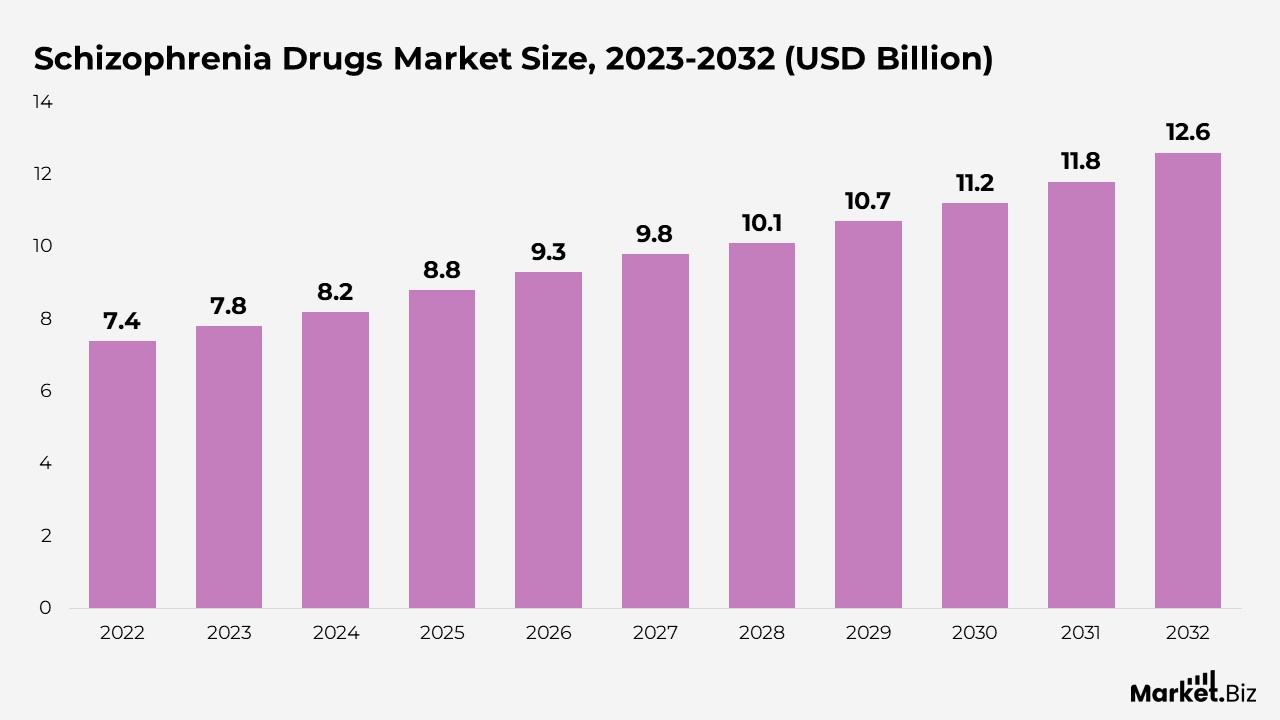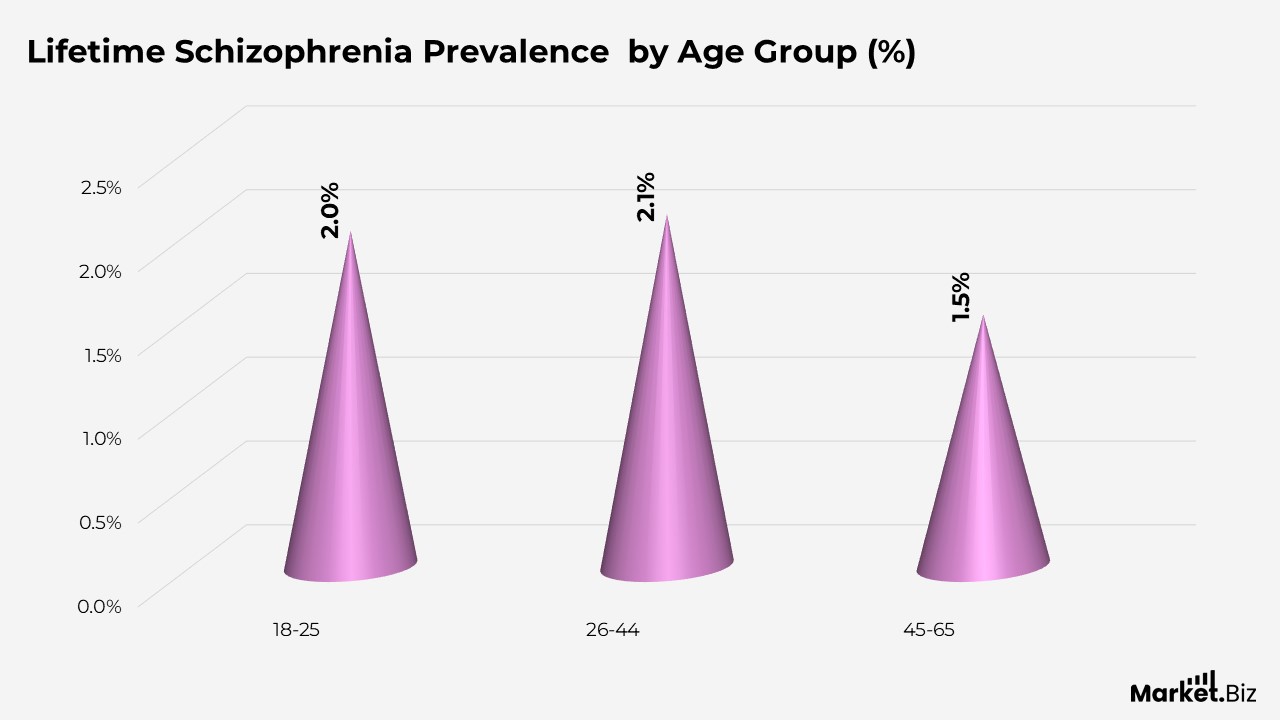Introduction
Schizophrenia Statistics: Schizophrenia is a complex and often debilitating mental health disorder that affects 24 million globally. It manifests through symptoms such as delusions, hallucinations, disorganized thinking, and reduced motivation, which significantly impair daily functioning. Despite its widespread impact, schizophrenia remains poorly understood, and many people with the condition fail to receive the care and support they need.
Global statistics on schizophrenia highlight concerning trends, with varying rates of prevalence across different countries. Early diagnosis and timely treatment are crucial for improving outcomes, but many people face considerable challenges in accessing care, including stigma, a lack of awareness, and insufficient mental health resources.
Editor’s Choice
- The increase in schizophrenia cases can be attributed to genetic factors, heightened awareness, escalating stress levels, and improvements in healthcare and mental health services.
- In 2023, 72.9% of adults diagnosed with schizophrenia received mental health care, with 90% of women and 57% of men accessing treatment.
- Despite the widespread nature of schizophrenia, an estimated 40% of people with the disorder do not receive sufficient treatment.
- Early diagnosis and timely intervention are essential for enhancing long-term outcomes and improving the quality of life for individuals living with schizophrenia.
- People who have schizophrenia are more vulnerable to other health conditions, including diabetes, cardiovascular disease, and substance use disorders.
- Schizophrenia prevalence rates differ by region, with urban areas showing 2.37 times higher rates than rural regions.
Schizophrenia Drugs Market Size Statistics

- The global schizophrenia drugs market is projected to grow from $8.8 billion in 2025 to $12.6 billion by 2032, with a CAGR of 5.6% from 2023 to 2032.
- The rising prevalence of schizophrenia and the development of innovative drugs are key market growth drivers.
- Second-generation antipsychotics led the market in 2022 due to superior efficacy compared to first-generation drugs.
- Oral antipsychotic formulations dominated in 2022, driven by patient convenience and ease of daily self-administration.
- Hospital pharmacies are projected to capture the largest market share, as schizophrenia treatment often involves hospitalization.
- North America held a 47% revenue share in 2022, supported by strong reimbursement frameworks and access to advanced therapies.
- Asia Pacific market is gaining traction due to increasing mental health awareness and rising healthcare investments.
(Source: Market.us)
What are the Symptoms of Schizophrenia?
Symptoms of schizophrenia are categorized into four main types:
- Positive Symptoms
- Delusions
- Hallucinations
- Disorganized behavior
- Disorganized speech or thinking
- Negative Symptoms
- Anhedonia
- Lack of motivation
- Flat affect or other speech
- Cognitive Symptoms
- Attention issues
- Memory problems
- Verbal fluency
- Executive functioning
(Source: Victoria State Government, Goldstar Rehabilitation, National Health Service)
Key Facts About Schizophrenia
- Schizophrenia causes psychosis and significant disability, affecting social, personal, and work life.
- People with schizophrenia face discrimination, stigma, and human rights violations.
- Over two-thirds of those with psychosis globally lack access to specialized mental health care.
(Source: World Health Organization)
Global Schizophrenia Statistics
- Schizophrenia impacted around 24 million people globally, or roughly 1 in 300 people (0.32%), with a higher prevalence of 1 in 222 adults (0.45%) in 2022.
- Schizophrenia affects approximately 1% of the global population.
- Around 1.5 million people are expected to be diagnosed with schizophrenia worldwide this year.
- Schizophrenia ranks among the top 15 leading causes of disability globally.
- There are 1.5 new cases of schizophrenia per 10,000 people globally.
- Among young adults, 1 in 222 people, or 0.45% of the global population, are affected by schizophrenia.
- Approximately 60% of people with schizophrenia encounter discrimination, stigma, and human rights violations at some point in their lives.
- Two-thirds of people who have psychosis, including those with schizophrenia, never receive the necessary healthcare for proper treatment.
- Although numerous treatment options are available for individuals with schizophrenia, only 1 in 3 will fully recover from the disorder.
- Approximately 70% of children with schizophrenia go undiagnosed during their childhood.
- Only about 20% of individuals with schizophrenia receive the necessary treatment to manage the most severe symptoms, enabling them to engage in daily activities normally. Less than 10% of those diagnosed fully recover.
- Around 80% of people with schizophrenia experience lifelong chronic illness.
(Source: Cross River Therapy, WebMD)
Effect on Daily Life and Functioning
- Nearly 90% of people diagnosed with schizophrenia experience challenges in education, family relationships, personal life, social interactions, and employment.
- 85% of those affected by schizophrenia require assistance in managing daily activities.
- 81% experience fluctuations in their symptoms, with periods of improvement and worsening over time.
- 75% of people with schizophrenia observe a progressive increase in their symptoms as time goes on.
(Source: Cross River Therapy, National Institute of Health )
Schizophrenia Cases by Country
- In the U.S., approximately 3.7 million adults (1.8% of the population) aged 18 to 65 have experienced schizophrenia spectrum disorders, reflecting a significant prevalence in this age group.
- Schizophrenia affects around 300,000 people in Canada, with an equal distribution between men and women, demonstrating its widespread impact across genders.
- In Europe, the prevalence of schizophrenia varies between 0.3% and 1.5%, highlighting its broad presence across the continent.
- France is home to roughly 600,000 people with schizophrenia, contributing to a global prevalence rate of 0.7% in 2024, reflecting the issue’s scale in Western Europe.
- The number of schizophrenia cases in Spain has risen to approximately 202,000, up from 199,900 the previous year, indicating growing diagnosis and awareness of the condition.
- In the U.K., over 685,000 people, or about 1% of the population, are living with schizophrenia, signifying the disorder’s substantial impact on public health.
- Sweden reported around 35,000 diagnosed cases of schizophrenia, indicating moderate prevalence within its healthcare system.
- In India, an estimated 3.5 million people live with schizophrenia, suggesting a significant burden of the disorder in the country’s vast population.
- Schizophrenia affects between 150,000 and 200,000 people in Australia, a considerable number given the country’s smaller population relative to larger regions.
- In Mexico, around 1 million people are living with schizophrenia, underlining the considerable mental health challenge faced by the Latin American population.
(Source: World Health Organization, Victoria State Government, National Institute of Health, RTI International, Schizophrenia Schizophrenia Society of Canada, European Breain Council, Paris Brain Institute, Statista, The University of Gothenburg, Market.us)
Demographics of Schizophrenia
Gender
- Schizophrenia symptoms in men usually appear between the ages of 17 and 24.
- Women typically exhibit symptoms later, between the ages of 27 and 33.
- The delay in symptom onset for women may be attributed to factors such as reluctance to seek psychiatric help and financial barriers to accessing care.
- In 2023, about 2.5 million adults (1.2% of the population) met the diagnostic criteria for schizophrenia spectrum disorders.
- Schizophrenia spectrum disorders were most prevalent among U.S. adults aged 26 to 44, with 1.5% of people in this group showing symptoms in the past year.
Race
- African Americans have the highest prevalence of self-reported schizophrenia diagnosis, with 21.1% of individuals receiving help for their symptoms.
- Among Hispanic Americans, 19.9% report being diagnosed with schizophrenia, indicating a notable but lower prevalence.
- Schizophrenia diagnoses among White Americans stand at 13.1%, reflecting a lower rate compared to African and Hispanic Americans.
- Asian Americans have one of the lowest rates of schizophrenia diagnoses, with only 5.4% reporting the condition.
- African Americans are 4 times more likely to be diagnosed with schizophrenia.
Age
- It is rare for children under 12 years old or adults over 40 to suddenly show signs of schizophrenia.
- While symptoms can develop at any age, the typical onset of the disorder usually occurs between 18 and 32 years for both women and men.

(Source: Cross River Therapy, Source: Substance Abuse and Mental Health Services Administration, Cross River Therapy)
Schizophrenia Prevalence in the U.S. Statistics
- In 2023, 3.7 million American adults (1.8% of the U.S. population) were affected by schizophrenia spectrum disorders.
- The highest prevalence of schizophrenia in 2023 was found in adults aged 26 to 44, a critical life stage.
- Men were more likely to be diagnosed with schizophrenia than women, with 1.5% of men affected compared to 0.9% of women.
- The suicide rate among people with schizophrenia is 4.9%, higher than that of the overall population, especially during the early stages of the illness.
- The suicide rate for men with schizophrenia was 88.96 per 100,000, compared to 56.33 per 100,000 for women.
- About 1% of the U.S. population is affected by schizophrenia each year, according to John Hopkins Medicine.
(Source: Los Angeles Outpatient Center, Cross River Therapy)
Schizophrenia-Related ED Visits in U.S. Adults (18–64)
- Each year, over 382,000 emergency department visits related to schizophrenia occur among adults aged 18-64, with an overall visit rate of 20.1% per 10,000 adults, highlighting the significant healthcare burden schizophrenia places on emergency services.
- Schizophrenia-related Emergency Department (ED) visits for men are 26.5% per 10,000, nearly double the rate for women, which stands at 13.8% per 10,000. This indicates a higher prevalence of severe episodes among men, necessitating targeted interventions.
- Around 32.7% of schizophrenia-related ED visits result in hospital admission, reflecting the severity of symptoms experienced during these visits, often requiring extended care.
- Nearly 16.7% of patients with schizophrenia are transferred to a psychiatric hospital after an ED visit, underlining the need for specialized mental health care and long-term treatment options.
- Roughly 50% of people with schizophrenia experience recovery from the disorder.
(Source: Centers for Disease Control and Prevention, Market.us, National Institute of Health)
The Cost Of Schizophrenia Statistics
- In the U.S., the annual cost of schizophrenia is estimated at $63 million, making it one of the most expensive mental health disorders, especially due to the significant medical and counseling expenses. This figure also includes costs for lost productivity, social services, and patient financial support.
- Globally, the direct annual costs of schizophrenia total around $62 billion, with $27.2 billion allocated to healthcare expenses and $14.5 billion spent on the incarceration of individuals with the disorder. The remaining funds cover housing and services for the homeless population.
- Worldwide, $115 billion is spent annually on lost wages due to caregiving responsibilities for those with schizophrenia, and an additional $104.5 billion is directed towards caregiving costs.
Top Companies Offering Medications
Eli Lilly and Company
- Eli Lilly and Company manufactures Zyprexa, an oral medication for schizophrenia.
- In 2023, Eli Lilly reported a total revenue of $34.1 million.
- Zyprexa alone contributed $1.45 billion to the company’s revenue in 2023.
(Source: Eli Lilly annual report, Statista)
Janssen Pharmaceuticals
- Johnson & Johnson offers Invega Sustenna, an injectable medication for schizophrenia treatment.
- The company achieved approximately $88.8 billion in sales in 2023.
- Based on total revenue, Johnson & Johnson was ranked as the leading global pharmaceutical company in 2023.
- As of 2022, the company was not among the top pharmaceutical companies in R&D intensity.
- Janssen Pharmaceuticals, a subsidiary of the U.S.-based healthcare giant Johnson & Johnson, plays a key role in its pharmaceutical operations.
- Johnson & Johnson is set to invest around $17 billion in research and development in 2024.
(Source: Statista, Johnson & Johnson annual report)
Pfizer Inc.
- Pfizer manufactures Geodon, an oral medication used in the treatment of schizophrenia.
- In 2024, Pfizer reported a total revenue of $63.6 billion in sales.
- Pfizer’s products are distributed globally, and as of 2022, the company was engaged in approximately 170 research and development projects.
(Source: Pfizer annual report, Statista)
H. Lundbeck A/S
- In 2024, Brintellix/Trintellix generated the highest revenue among the products of the Danish pharmaceutical company Lundbeck.
- Revenues from Brintellix/Trintellix reached approximately kr4.85 billion in that year.
- Following closely was Rexulti/Rxulti, which generated around kr3.9 billion in revenue.
- H. Lundbeck A/S, established in 1915 and headquartered in Copenhagen, specializes in pharmaceuticals for the nervous system.
(Source: Statista, Market.us)
AstraZeneca
- AstraZeneca offers Seroquel, an oral medication used in the treatment of schizophrenia.
- In 2024, the British-Swedish biopharmaceutical company reported revenues of approximately $54 billion, marking its sixth consecutive year of substantial growth.
(Source: Statista, Market.us)
Recent Developments
New Drug Approvals
- In February 2025, Teva Pharmaceuticals, an Israeli multinational pharmaceutical company, and Medincell announced that the U.S. Food and Drug Administration (FDA) had approved UZEDY as a subcutaneous long-acting injectable (LAI) for schizophrenia treatment in adults, with dosing options every one or two months.
- In September 2024, the FDA approved Cobenfy (xanomeline and trospium chloride) capsules as an oral treatment for schizophrenia in adults. This approval introduces the first antipsychotic drug targeting cholinergic receptors, offering an innovative alternative to the conventional approach of targeting dopamine receptors in schizophrenia treatment.
Acquisitions
- In March 2024, Bristol Myers Squibb, an American multinational pharmaceutical company, acquired Karuna Therapeutics, Inc. to enhance its neuroscience portfolio and collaborate with Karuna’s team to bring KarXT to patients with schizophrenia later in the year.
- Research Foundation has teamed up with PharmaGiant Inc. to further schizophrenia genetics research, with a combined investment of $50 million dedicated to genome-wide association studies and biomarker discovery.
Funding and Grants
- In March 2023, Rohini Nilekani Philanthropies announced a grant of $12.1 million (₹100 CR) to the National Institute of Mental Health and Neurosciences (NIMHANS) and the National Centre for Biological Sciences (NCBS) to accelerate research and treatment for five major mental health disorders – schizophrenia, obsessive-compulsive disorder, bipolar disorder, dementia, and addiction.
- In November 2022, the NSW Government invested $4 million to support research projects focused on ways to understand schizophrenia better and improve the lives of those who live with it.
Epidemiological Studies
- A thorough epidemiological study by the Global Health Institute found that schizophrenia has a global prevalence rate of 0.5%, affecting approximately 20 million people worldwide.
- The study also highlighted regional differences, with urban areas reporting higher prevalence rates than rural regions, suggesting that environmental factors play a significant role in disease risk.
Strategic Policy Measures
- Government bodies introduced mental health parity laws and boosted funding for community mental health initiatives to enhance access to care for individuals with schizophrenia. These efforts are aimed at reducing disparities in treatment and encouraging early intervention.
- Advocacy groups have actively promoted greater public awareness and efforts to destigmatize schizophrenia, resulting in improved societal understanding and increased support for those living with the condition.
Conclusion
The global burden of schizophrenia is on the rise, particularly in low and middle-income countries where improvements in infant and childhood mortality have been made. Schizophrenia is a prevalent mental health disorder that affects millions worldwide, transcending age, gender, and socio-economic status.
Early diagnosis plays a crucial role in improving outcomes and enhancing the quality of life for individuals living with schizophrenia. Unfortunately, many people are not receiving the necessary care due to factors like stigma, lack of awareness, and insufficient mental health resources.
Ongoing research is essential to gain a deeper understanding of the causes, risk factors, and potential treatments for schizophrenia. The current statistics emphasize the need for greater awareness, resources, and support to address this complex and challenging disorder.
FAQ’s
Schizophrenia is a complex mental health disorder marked by a range of symptoms, including delusions, hallucinations, disorganized thought patterns, and speech, along with diminished interest or motivation in daily activities.
Schizophrenia symptoms are typically classified into three main categories: positive, negative, and cognitive symptoms.
Positive Symptoms
– Delusions
– Hallucinations
– Disorganized behavior
– Disorganized speech or thinking
Negative SymptomsAnhedonia
– Lack of motivation
– Flat affect or other speech
Cognitive SymptomsAttention issues
– Memory problems
– Verbal fluency
– Executive functioning
Schizophrenia affects approximately 1% of the world’s population, though its prevalence can vary across different regions.
Schizophrenia treatment usually includes a combination of antipsychotic medications, therapy, and various support services. Medications help manage the positive symptoms, while therapy addresses cognitive and negative symptoms. Additionally, support services such as vocational training and housing aid are crucial in helping individuals with schizophrenia lead more independent lives and improve their overall well-being.
